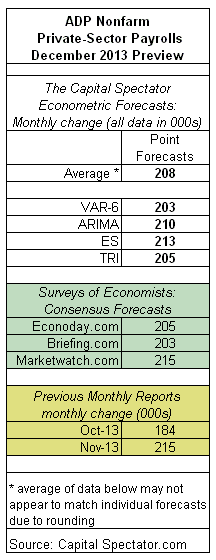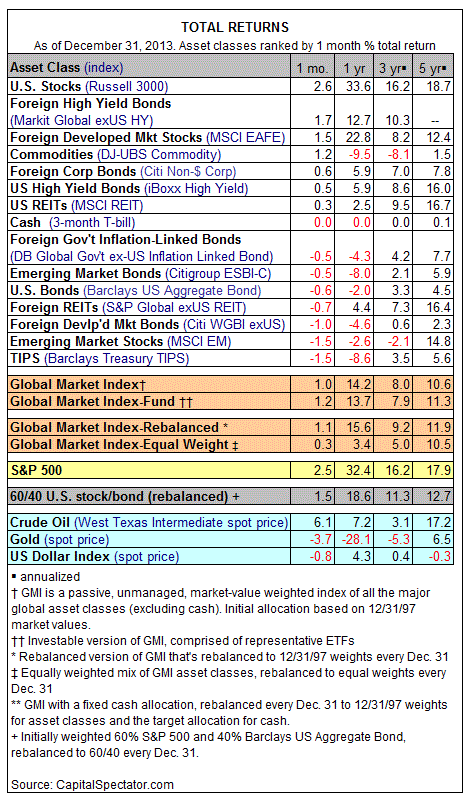Dynamic Asset Allocation Strategies Based on Unexpected Volatility
Valeriy Zakamulin (University of Agder) | Nov 2013
In this paper we document that at the aggregate stock market level the unexpected volatility is negatively related to expected future returns and positively related to future volatility. We demonstrate how the predictive ability of unexpected volatility can be utilized in dynamic asset allocation strategies that deliver a substantial improvement in risk-adjusted performance as compared to traditional buy-and-hold strategies. In addition, we demonstrate that active strategies based on unexpected volatility outperform the popular active strategy with volatility target mechanism and have the edge over the widely reputed market timing strategy with 10-month simple moving average rule.
The Global Multi-Asset Market Portfolio 1959-2012
Ronald Q. Doeswijk, et al. (Robeco) | Nov 2013
The global multi-asset market portfolio contains important information for strategic asset-allocation purposes. First, it shows the relative value of all asset classes according to the global financial investment community, which one could interpret as a natural benchmark for financial investors. Second, this portfolio may also serve as the starting point for investors who use a framework in the spirit of Black and Litterman (1992), or for investors who follow adaptive asset-allocation policies as advocated by Sharpe (2010). We estimate the invested global market portfolio for the period 1990-2012 by estimating the market capitalization for the eight asset classes: equities, private equity, real estate, high-yield bonds, emerging-market debt, investment-grade credits, government bonds and inflation-linked bonds. For the main asset categories – equities, real estate, non-government bonds and government bonds – we extend the period to 1959-2012. We provide these annual historical estimates in tabular form so that practitioners and academics can easily use these historical data going forward. Next, we compare the asset allocations of institutional global investors to the market portfolio. To our knowledge, we are the first to document the global multi-asset market portfolio at these levels of detail for such a long period of time.
Dynamic Risk Allocation with Carry, Value and Momentum
Boris Gnedenko and Igor Yelnik (ADG Capital Mgt) | Nov 2013
According to recent research, diversification across risk factors (or investment styles) proves to be more efficient than traditional asset class diversification. In this paper, we take the next step and show that it is economically worthwhile to combine risk factors in a dynamic manner, in a process that we call Dynamic Risk Allocation (DRA). Building a DRA portfolio by means of several unconventional heuristics adds robustness and intuition to the whole portfolio construction process. Our main finding is that risk factor allocation largely replaces traditional global equity and bond market premiums as well as allocation to hedge funds (in expected utility maximization sense). Hence we question the economic validity of the alpha-beta separation paradigm that currently prevails in the industry. Adopting existing optimal rebalancing techniques, we show that our results are robust to transaction costs. Our empirical analysis is made for a global portfolio of 3 well-known risk factors: momentum, value and carry. To minimize data mining effects, each risk factor is broadly diversified across 4 global asset classes and taken both in cross-sectional and time series contexts. We test our approach using 38 years of daily historical prices in a broad set of futures contracts and major FX rates.
Investing in Systematic Factor Premiums
Kees C. G. Koedijk (Tilburg University), et al. | Aug 2013
Investments in certain segments of the market realize better returns over longer periods than those in other segments. Leading academic studies from the eighties onwards demonstrate, for instance, that value, momentum, smallcap and low-volatility stocks systematically generate higher risk-adjusted returns.
Investments in these segments or factors are also known as anomalies, as these factors cannot be explained by classic investment theories. However, allocation by institutional investors to strategies that explicitly capitalize on the benefits of these factors is now supported by academic research.
This report takes as its starting point the study by researchers Ang, Goetzmann and Schaefer (2009) for the Norwegian Government Pension Fund, the first such study to explicitly recommend factor investing. This pension fund is one of the largest active investors in the world. When in 2008 ten years’ worth of cumulative outperformance was wiped out, the fund launched an investigation to evaluate the effects of active management. The researchers concluded that the exposure to factor premiums clearly accounted for the fund’s results. Their conclusion is clear: factor investing must be part of the strategic asset allocation of institutional investors. However, this begs further questions:
•what is the added value of factor investing?
•what are these underlying factors?
•how can a pension fund best put together a portfolio?
This report provides answers to these questions. As a follow-up to the study by Ang, Goetzmann and Schaefer, it is very topical, as many institutional investors are investigating the opportunities provided by factor investing.










